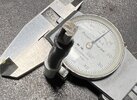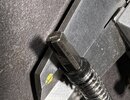You are using an out of date browser. It may not display this or other websites correctly.
You should upgrade or use an alternative browser.
You should upgrade or use an alternative browser.
Glock 19 broken firing pin issue???
- Thread starter brud720
- Start date
- Replies 20
- Views 439
No I can’t, my range is at home on a grassy pasture to say at best with I’d dare to say 100 plus different 9mm pistols shooting 100k plus rounds. And I have not saved any from this pistol. Glock asked for sample rounds also and I “think”I provided the rounds from this gun.Can you post pics of a fired case (or several if you have them), 1 showing a profile and 1 with case head with primer?
What modifications have been made to the gun?
1) Is that an OEM striker spring? It looks far shinier than any OEM Glock striker spring I’ve seen.
2) The spacer sleeve in the photo looks white. Aren’t all Glock spacer sleeves black?
As @BrettB has inquired, @brud720 it would be helpful to list all non-OEM parts in this pistol otherwise there’s really no informed discussion to be had. Further, @Catfish is requesting a look at the spent primers likely to look for signs of excessive primer drag. This info would also be useful.
2) The spacer sleeve in the photo looks white. Aren’t all Glock spacer sleeves black?
As @BrettB has inquired, @brud720 it would be helpful to list all non-OEM parts in this pistol otherwise there’s really no informed discussion to be had. Further, @Catfish is requesting a look at the spent primers likely to look for signs of excessive primer drag. This info would also be useful.
Last edited:
Dirtydirtysouf
Well-Known Member
Do the old palm the back of the slide with ur weak hand and shoot one round at a time. The slide won't cycle fully and you can keep/save the rounds to send off. Wear some gloves.No I can’t, my range is at home on a grassy pasture to say at best with I’d dare to say 100 plus different 9mm pistols shooting 100k plus rounds. And I have not saved any from this pistol. Glock asked for sample rounds also and I “think”I provided the rounds from this gun.
Average Joe
Just A Everyday Joe
2A Bourbon Hound 2024
2A Bourbon Hound OG
Benefactor
Life Member
Supporting Member
Multi-Factor Enabled
More info is needed. It appears that the spring cups have a lot of damage as well. Can you take more detailed close ups of the beech face, striker, striker spring, spring cups and if possible, the striker channel.
That looks like a Gen1-4 striker. Back around the time of the Gen4 introduction, Glock switched strikers from being investment cast to MIM. The thin striker tip is the weakest part, so it tends to be where one will break and breakages did increase. The Gen5 offered a new design striker that is more conventionally designed and lessens the likelihood of a striker breaking while still being MIM. The short of it is that snap-caps should be used if dry-firing (because you can also break the breechface with enough dry-fires) and the earlier generation strikers are more prone to breakage.
For your particular example, it could be something wrong in the breechface like a burr or maybe the striker channel sleeve could be broken. I would simply keep a spare striker assembly and possibly send to back into Glock again.
For your particular example, it could be something wrong in the breechface like a burr or maybe the striker channel sleeve could be broken. I would simply keep a spare striker assembly and possibly send to back into Glock again.
Hold on hold on are you saying that glocks have malfunctions and parts break just like every other gun ever made? And that they are not immune to damage or wear and tear? Do all the die hard plastic fantastic guys no about this 🤣 sorry about throwing un needed smartassery into the thread I just couldn't help myself.
georgel
Behind Every Blade of Grass
Charter Member
Benefactor
Supporting Member
Multi-Factor Enabled
No, we're not...Hold on hold on are you saying that glocks have malfunctions and parts break just like every other gun ever made?
Hold on hold on are you saying that glocks have malfunctions and parts break just like every other gun ever made? And that they are not immune to damage or wear and tear? Do all the die hard plastic fantastic guys no about this 🤣 sorry about throwing un needed smartassery into the thread I just couldn't help myself

Dirtydirtysouf
Well-Known Member
I'll clear it up....some people say Glocks never break and 1911's are garbage. Now this thread is showing that Glocks break and some people are freaking out about it.This thread leaves me so confused...
If it’s got moving parts it will break in time. This is my first time with firing pin issues. But I’ve owned a Glock since 91 and they will break usually after 20k plus rounds though.I'll clear it up....some people say Glocks never break and 1911's are garbage. Now this thread is showing that Glocks break and some people are freaking out about it.
On the way back to Glock sent them some pics and from the tone of the email they were scratching there heads also. We will see when it comes back.That looks like a Gen1-4 striker. Back around the time of the Gen4 introduction, Glock switched strikers from being investment cast to MIM. The thin striker tip is the weakest part, so it tends to be where one will break and breakages did increase. The Gen5 offered a new design striker that is more conventionally designed and lessens the likelihood of a striker breaking while still being MIM. The short of it is that snap-caps should be used if dry-firing (because you can also break the breechface with enough dry-fires) and the earlier generation strikers are more prone to breakage.
For your particular example, it could be something wrong in the breechface like a burr or maybe the striker channel sleeve could be broken. I would simply keep a spare striker assembly and possibly send to back into Glock again.



